Like many upper-level eventers, I’ve ridden every kind of horse you can imagine. I enjoy taking a horse who is a little unsure of himself—whether in dressage, cross country or even just in the state of his life—and figuring out a program to give him confidence. In the long run, my goal is stronger communication and a better partnership with my horse. That’s when I feel ready to take on any challenge because partnership is what it’s all about for me.
I don’t have a set program. I use the basic principles I’ve learned from some of the best riders in my sport to individualize everything I do. I’d like to show how my approach works by talking about two contrasting horses I’ve taken to CCI*** level or higher recently—River King (Riley), a Holsteiner, and Here’s To You (Quincy), a Thoroughbred. I’ll focus on what I needed to do to train each of them to handle a classic upper-level cross-country question, the sunken road.
Training Total Opposites
Physically, eventing is easy for Riley—he’s brave, naturally athletic and built uphill. When he came to me, he was already going at CCI** level and he could just pick up his legs over the fences without making a real effort. The biggest physical piece he was missing was that he didn’t know how to round himself over the jump, which I knew would cause us some iffy moments when he moved up to CCI***, because at that level and higher the spacing between elements in combinations requires the horse to be able to compress into a ball. If he doesn’t round over the jump, he can’t become a ball. There was a lot to do in terms of teaching Riley to use his body as a whole.
Mentally, the biggest challenge with Riley was getting him to focus on what was ahead. When there were several elements close together, like a sunken road, he would look down at what was behind the first element just as he was taking off over it and twist, hit the jump or lose his line, making the striding difficult for the next few elements.
The physical questions that Riley found easy were a huge challenge for Quincy, who has a powerful hind end but is built downhill and otherwise needed so much work on his front-end form that we used to call him “spaghetti legs.” Often his hind end pushed before his front end realized it needed to move. If upper-level horses aren’t quick enough with their footwork, it’s hard for them to make adjustments as they go. Quincy needed to develop his footwork to the point where his muscle memory came into play when he didn’t have time to think about a situation. I knew that the better upper-level horses are with their footwork, the more options they give themselves and the less likely they are to make mistakes.
When I first saw him, Quincy might not have looked like CCI**** material, but I had a great feeling about him from the time he came to me as a Preliminary horse because he had the scope, power and desire to get to the other side of any jump. My job was to help him develop his front-end technique.
Mentally, Quincy was easier to ride than Riley because Quincy is very sharp and aware of what is coming up on course. His brain, however, tended to get going so fast that his body, especially his front end, couldn’t catch up. His default setting was to push off the ground harder with his hind end and jump bigger. This could put him too close to the next element, making it difficult to jump.
In general, on cross country I want my horses’ minds to be going slowly—really analyzing the questions—while their bodies respond quickly. Whenever I focused on a specific question such as the sunken road with Quincy and Riley, I went back to that ideal. With Quincy, I needed to slow everything down, making the elements small and easy for him to execute correctly. With Riley it was the opposite. Our exercises at home had to be significant enough to make him realize he should care and pay attention. If I set the same exercise for both horses, I would set it at 2-foot-6 for Quincy because he is just as aware of a 2-foot-6 fence as a 4-foot-6 fence. But for Riley I had to start right off substantial enough to challenge him in order to create his awareness and sharpen his mind.
Now let’s take a look at the question we’re going to analyze, the sunken road, and how it challenged each horse. In the photos on the following pages, I’m demonstrating on my newest horse in the barn, Shame on the Moon (Delta).
Sunken-Road Elements
First, what is it?
A sunken road at Advanced consists of an “in” jump, usually a vertical fence immediately followed by a bounce or a one-stride and then by a substantial vertical drop. After the drop comes a one-stride distance across the “road” before the horse jumps up the bank that forms the other side, and right after the up-bank is another jumping effort, the “out” jump. The in element is fairly consistent in terms of the question it asks. On the way out, however, harder courses will ask you to jump something that requires a lot more power; you have to show your horse can maintain his power through the very technical earlier part of the question. This out element can be quite varied. At a CCI****, it might be two strides to a giant corner, whereas at an Advanced horse trial, it might be a bounce to a plain, small rail.
The sunken-road question includes all the elements needed for a good cross-country ride: It requires balance and coordination from both the horse and rider, plus the ability for them to communicate while everything is changing rapidly. On the approach, after riding a transition from a gallop to a balanced canter, both my horse and I need the presence of mind—one of the biggest factors—to read the question and jump through it properly. Personally, I find the biggest challenge in this question is for both horse and rider to rebalance after landing from the drop. The horse lands in the road with all his weight on his front end and must shift his weight back to jump out. If a rider loses her position during this quick transition at the Advanced level, there isn’t time to regain it.
Next, how to teach it?
In general, when training a horse or rider to ride a sunken road, I break the question into separate pieces. I start with schooling a plain drop, then add an element before the drop. Separately, we work on the up-bank and then an up-bank with another element beyond. Often, when the drop portion of the exercise is going well, I add a small (about 2-foot) bounce one or two strides from the bottom of the drop. This is a forgiving way to determine whether the horse can land, get his balance back and be quick with his legs before I present him with an up-bank soon after the drop. Up-banks are not the most forgiving fences, and it’s easy for a green horse to trip when jumping up. Once I feel the horse or student is confident with these elements, I’ll trailer to a facility that has a real sunken road, one with two or three strides across the bottom, to put it all together.
This was the basic program I used to teach Quincy and Riley to negotiate a sunken road, but because they were such different individuals, I had to adapt my method to each of them.
Riley: Learning To Look Down
Riley had already dealt with sunken roads before I got him and had plenty of confidence about the question. I knew, however, that when we moved up to Advanced he would have to be able to change his shape and adjust his body, not just get his legs out of the way. Advanced horses need to keep their balance up but they have to learn to look down so that they know where they’re putting their feet. It also goes along with creating a rounder shape in their bodies so they can compress. Because Riley didn’t focus on his jumps ahead of time, he wouldn’t look down at what was behind the first element until just as he was taking off over it—and then he’d become unbalanced. (That problem didn’t show up until he had to jump the rail before the sunken road and then bounce down the drop.)
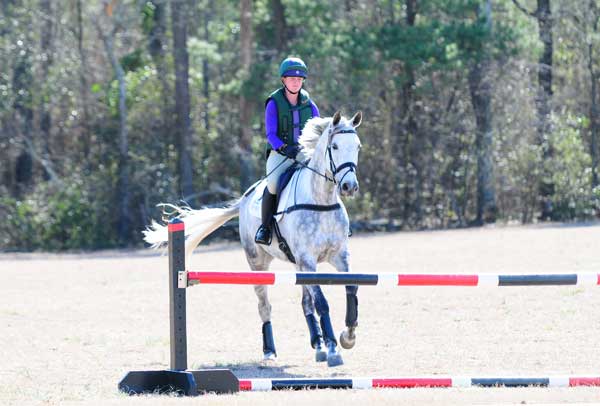
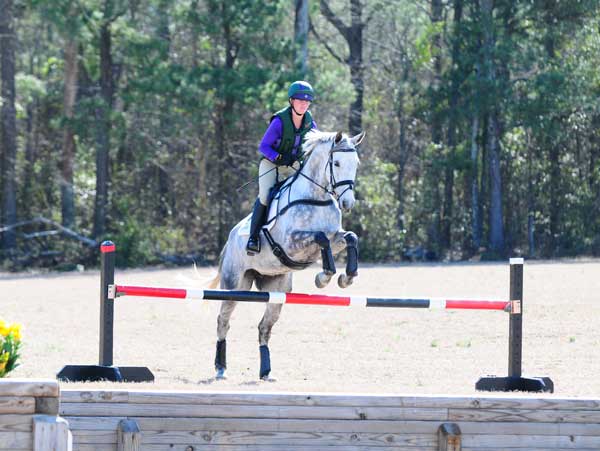
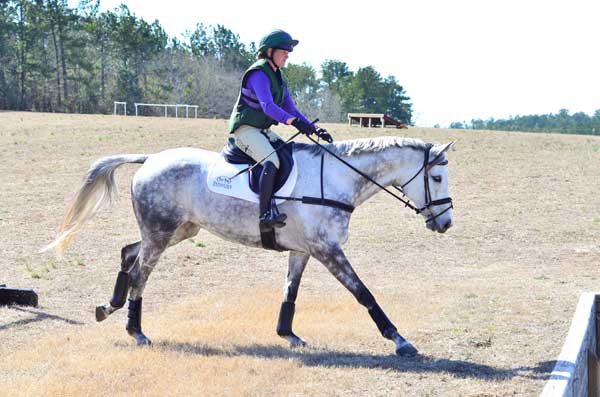
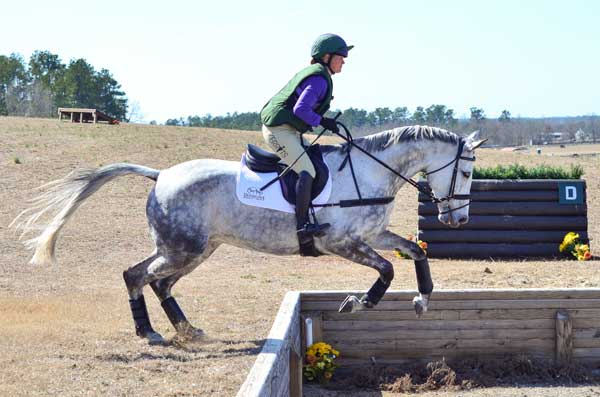
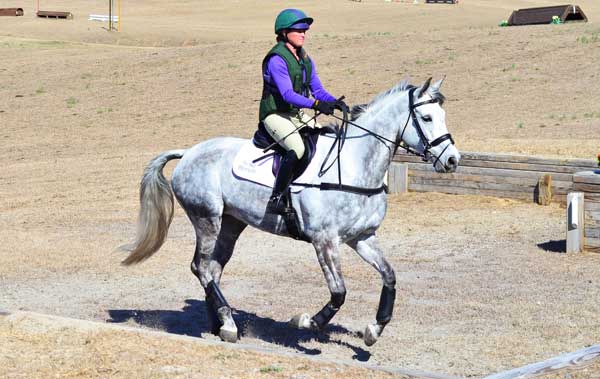
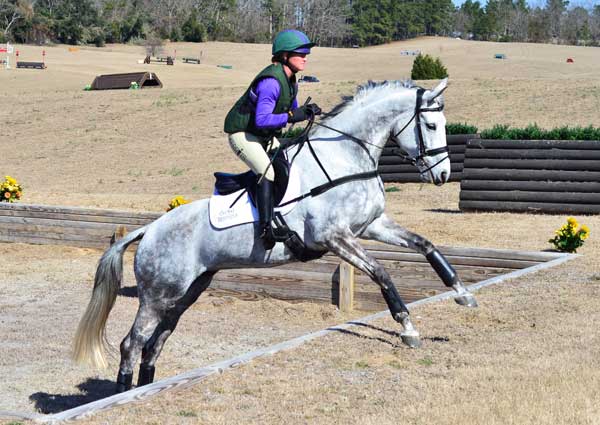
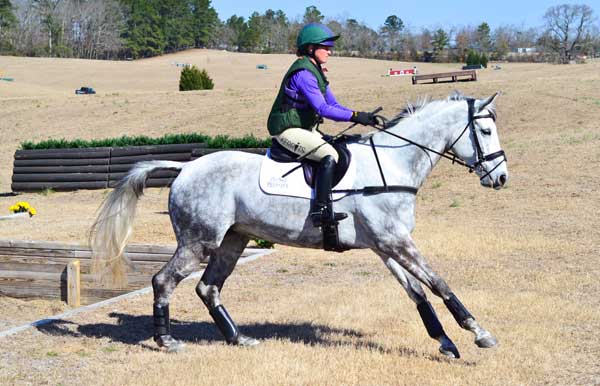
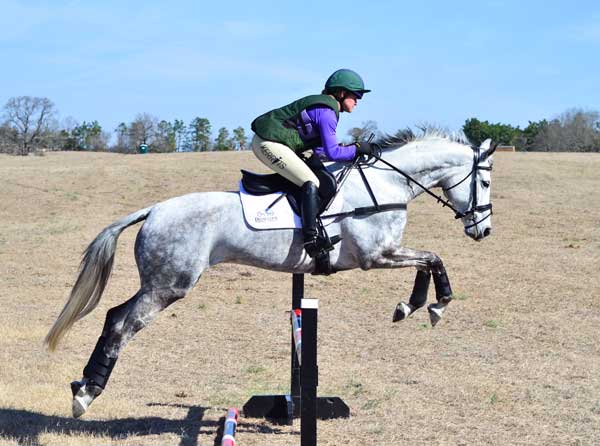
As general preparation, we did tons of cavalletti work so Riley had to watch what was in front of him. We also did lots of jumping schools where I varied the elements of the jumps so he had to change his shape. We might go from a tall, airy jump to something low and wide in a bounce or one-stride. I always varied the distances so he never got used to doing it just one way, and sometimes I put something solid like a flower box at the base of the wide jump to encourage him to look at it. I had to keep thinking.
As a rider, you have to be careful in something like a sunken road that you’re guiding your horse but not interfering with him. As a rider, you never want to distract your horse during his jumping effort, and a question like a sunken road is a continuous jumping effort rather than a series of individual jumps. Plenty of times during the process of trying to teach Riley to look where he was going, as I was galloping along and then trying to set him up for the question, I would end up circling in front of the fence instead. I didn’t want him thinking he could halfway listen to me and just brace and bully his way through—but I also didn’t want to be holding and restricting him through the question because that wasn’t going to do him any favors as far as learning to use his body more correctly.
The other part of the challenge was convincing him to ride a transition from the gallop to the frame and speed we needed for the question. I thought we had all these pieces together when we got to the Bromont CCI*** in June 2013. We were having a great run when we came to a massive drop followed by a turn to jump two narrow angled cabins. I thought I had gotten him back enough on the approach. “Surely when he sees that big drop, he’ll pause,” was my reasoning—but he didn’t pause, he just launched off the drop because he couldn’t see the next element around the turn, and then there was no way in the world to turn and line up the cabins. We ended up with 20 penalties because we had to circle at the bottom. We spent the summer back at the drawing board, working on the concept, “Even if you don’t see something, you have to listen to me!” Over and over, I took him up the bank in my little schooling field, asked him to add a stride before jumping the little fence on the top, then jumped back down and circled. The critical part of this exercise was the little fence before the drop: I didn’t want to pound on Riley by practicing over a big drop, but I knew he would just hop off a 2- or 3-foot drop without rounding himself and pushing. The small jump at the top of the bank essentially forced him to make a bigger effort off the small drop. He learned to land softer, and then he could listen to me. It was a lot of repetition.
Quincy: “Use Your Parts, Not Your Power!”
The very aspect of Quincy that I thought gave him international potential—his power—was what we struggled with at technical questions like the sunken road. Although he was somewhat spooky in the beginning, he’s not a horse who backs off his jumps. He tends to jump very big off the drops, and his downhill build made it hard for him to recover his balance and be quick and sharp with his front legs; rather than work his front legs, he tried to jump higher. If he got through a combination the first time but was very awkward on the way out, that scared him so he jumped higher and harder the next time. He would find a way out of it, but the awkward jump increased his chances of losing his confidence.
I started working with Quincy sooner in his career than I did Riley, so our communication was better established. His previous owner, Rebecca Polan, came to work with me a little and I competed him in his first Prelim. I learned that we needed to approach a question like the sunken road feeling almost underpowered, giving Quincy time to think instead of jumping himself into trouble. Everything I do with him goes back to the concept “Use your parts, not your power!” Another challenge is that he doesn’t accept the bit well. I do a lot of his schooling and conditioning in a hackamore or a bitless bridle because we accomplish more when he’s not fussing with his bit.
When it came to the sunken road, riding a transition from gallop back to a more compressed frame was a bit easier with Quincy than it was with Riley because Quincy was so focused on the jump that he would look at it and hold himself a little. My focus was teaching him to use his front legs better and be quicker with his feet; otherwise, he got slow with his legs and his hind end pushed before his front end. In schooling, I added small placing poles at a variety of distances and bounce rails before the different elements, between elements—everywhere! We approached everything slowly, and the numerous elements encouraged him to keep his parts moving. I gradually built up the jumps so he learned that just because they got a foot higher, it didn’t mean he could disregard everything else and just jump big. He had to concentrate on what was ahead of him and think about it. This was very important in the out phase of the sunken road, where he could easily jump so hard up the bank that he got too close to the final element.
I knew I had turned a corner with Quincy in 2011 at our second CCI*** at Fair Hill International in Maryland, when Karen O’Connor asked how our cross country went and I said, “His brain was in slo-mo the whole way around!” I realized he could finally slow his mind and think about each step instead of just leaping. We finished in the top 10 at that competition and entered the Rolex Kentucky Three-Day Event CCI**** the following spring. Our cross-country trip there was super except for a glance-off at Fence 9C (The Coffin), where the ditch took Quincy by surprise. He caught a front leg because, as I realized afterward, I had surprised him by riding him more aggressively than usual on the approach. He got his legs back underneath him in time to avoid what looked in some photos like an imminent rotational fall, but we lost our line to the next element. His overall performance convinced me that he was ready for international competition and we went to Blenheim Palace International Horse Trials CCI*** in England that fall. After a fabulous dressage test that earned a 44, I defaulted to my “protective mother” mode from concern that he felt subpar in our jumping schools, and we went more slowly than we needed to around cross country. I had time faults and lots of horse left at the end. When we show-jumped clear the next day, I was kicking myself, but I also knew that Quincy really belonged there.
The Wrap-up
My results with Riley, Quincy and other horses have strengthened my confidence in my training program and how I fine-tune it for each individual. Because I’ve produced Quincy from Preliminary on up, when I got Riley as an Intermediate eventer in 2012, I trusted what I was doing enough to prepare him for Advanced. I also had the confidence to recognize in late 2013 that, despite the huge improvement in his cross-country form, international eventing was not going to be the career for Riley as I had hoped. As he got more rideable, soft and smooth, he also got more casual about touching the jumps he had previously leaped over (if somewhat erratically) in stadium. I knew I was dealing with a horse who, from the beginning, didn’t care much what was in front of him. I couldn’t create in him a desire not to touch those poles on the last day. He’s very happy in his new job as a Young Rider horse.
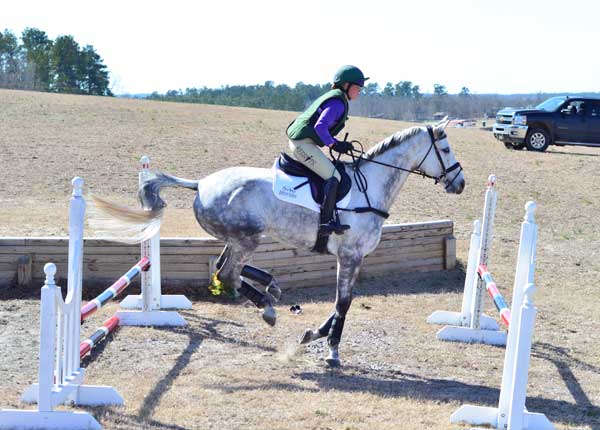
Meanwhile, with Quincy I can’t wait for the day when all the pieces come together and he can shine. I know he’s capable of that. If he does well at Rolex this spring, we would love to go overseas again.
Emily Beshear’s life with horses began in Michigan with the unbroken 4-year-old pony her mother bought when Emily was 6. “It was serious trial and error while I was growing up,” she laughs. Early involvement in 4-H fueled her competitive urge and fate took a hand when the first lesson barn her mother found was an eventing facility, Margaret Spencer’s Burlwood Stables. Emily was inspired to push herself after taking her first trip to Rolex at age 10 with a group from the barn.
Her success in the sport has been “a matter of being in the right place and connecting with the right people early on,” she believes. Clinics with top eventing trainers like Jim Wofford and Karen and David O’Connor were important during her teens. Dressage trainer Gerd Zuther challenged her during a dressage clinic to use more upper-level dressage movements. She credits eventer Ralph Hill with “getting me inside the mind of each individual horse and tailoring the training program to the way each thinks.”
Today Emily operates Brickland Eventing in Somerset, Virginia, with her husband, sporthorse veterinarian Jeffrey Beshear; their son, Nicholas, age 10, is an enthusiastic soccer player. A popular trainer, Emily is a certified U.S. Eventing Association Level 4 ICP instructor. Currently, she’s focused on “getting myself on horses that are not only competitive at the upper levels but will be competitive internationally.” (Her plans to compete abroad in 2013 were delayed when she decided to withdraw Quincy from the Rolex CCI**** due to a slight soft-tissue injury he sustained during a warm-up.)
Newest in her barn is Shame on the Moon (Delta), a 7-year-old Trakehner/Thoroughbred mare by Sonnet Seeker. “She has all the attributes we want: She’s a beautiful mover, brave, down to earth, with plenty of areas I feel I can develop.”
This article originally appeared in the May 2014 issue of Practical Horseman.










